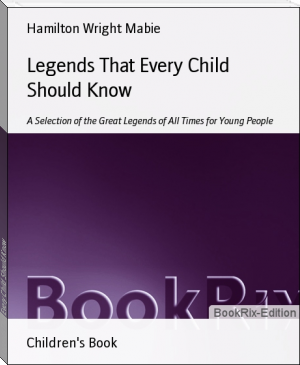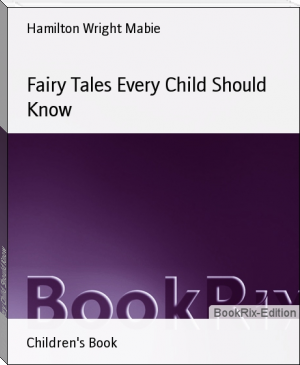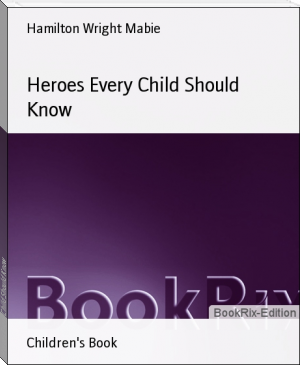Legends That Every Child Should Know, Hamilton Wright Mabie [good novels to read in english TXT] 📗

- Author: Hamilton Wright Mabie
Book online «Legends That Every Child Should Know, Hamilton Wright Mabie [good novels to read in english TXT] 📗». Author Hamilton Wright Mabie
INTRODUCTION
If we knew how the words in our language were made and what they have meant to successive generations of the men and women who have used them, we should have a new and very interesting kind of history to read. For words, like all other creations of man, were not deliberately manufactured to meet a need, as are the various parts of a bicycle or of an automobile; but grew gradually and slowly out of experiences which compelled their production. For it is one of the evidences of the brotherhood of men that, either by the pressure of necessity or of the instinct to describe to others what has happened to ourself and so make common property of personal experience, no interesting or influential or significant thing can befall a man that is not accompanied by a desire to communicate it to others.
The word legend has a very interesting history, which sheds light not only on its origin but on early habits of thought and customs. It is derived from the Latin verb legere , which means "to read." As legends are often passed down by word of mouth and are not reduced to writing until they have been known for centuries by great numbers of people, it seems difficult at first glance to see any connection between the Latin word and its English descendant. In Russia and other countries, where large populations live remote from cities and are practically without books and newspapers, countless stories are told by peasant mothers to their children, by reciters or semi-professional story-tellers, which have since been put into print. For a good many hundred years, probably, the vast majority of legends were not read; they were heard.
When we understand, however, what the habits of people were in the early Christian centuries and what the early legends were about, the original meaning of the word is not only clear but throws light on the history of this fascinating form of literature. The early legends, as a rule, had to do with religious people or with places which had religious associations; they were largely concerned with the saints and were freely used in churches for the instruction of the people. In all churches selections from some book or books are used as part of the service; readings from the Old and New Testament are included in the worship of all churches in Christendom. In the earliest times not only were Lessons from the Old Testament and the Gospels and Epistles of the New Testament read, but letters of bishops and selections from other writings which were regarded as profitable for religious instruction. Later stories of the saints and passages from the numerous lives which appeared were read at different services and contributed greatly to their interest. The first legends in Christian countries were incidents from the lives of the saints and were included in the selections made from various writings for public worship; these selections were called
legends . The history of the word makes clear, therefore, the origin and early history of the class of stories which we call legends.
The use of the stories at church services led to the collection, orderly arrangement and reshaping of a great mass of material which grew rapidly because so many people were interested in these semi-religious tales. In the beginning the stories had, as a rule, some basis in fact, though it was often very slight. As time went on the element of fact grew smaller and the element of fiction larger; stories which were originally very short were expanded into long tales and became highly imaginative. In the Thirteenth Century the Legenda Aurea , or Golden Legend, which became one of the most popular books of the Middle Ages, appeared. In time, as the taste for this kind of writing grew, the word legend came to include any story which, under a historical form, gave an account of an historical or imaginary person.
During the Middle Ages verse-making was very popular and very widely practised; for versification is very easy when people are in the habit of using it freely, and a verse is much more easily remembered than a line of prose. For many generations legends were versified. It must be remembered that verse and poetry are often very far apart; and poetry is as difficult to compose as verse is easy. The versified legends were very rarely poetic; they were simply narratives in verse. Occasionally men of poetic genius took hold of these old stories and gave them beautiful forms as did the German poet Hartmann von Aue in "Der Arme Heinrich." With the tremendous agitation which found expression in the Reformation, interest in legends died out, and was not renewed until the Eighteenth Century, when men and women, grown weary of artificial and mechanical forms of literature, turned again to the old stories and songs which were the creation of less self-conscious ages. With the revival of interest in ballads, folk-stories, fairy stories and myths came a revival of interest in legends.
The myths were highly imaginative and poetic explanations of the world and of the life of man in it at a time when scientific knowledge and habits of thought had not come into existence. The fairy story was "a free poetic dealing with realities in accordance with the law of mental growth, ... a poetic wording of the facts of life, ... an endeavour to shape the facts of the world to meet the needs of the imagination, the cravings of the heart." The legend, dealing originally with incidents in the lives of the saints and with places made sacred by association with holy men, has, as a rule, some slight historical basis; is cast in narrative form and told as a record of fact; and, in cases where it is entirely imaginative, deals with some popular type of character like Robin Hood or Rip Van Winkle; or with some mysterious or tragic event, as Tennyson's "Idylls of the King" are poetic renderings of part of a great mass of legends which grew up about a little group of imaginary or semi-historical characters; Longfellow's "Golden Legend" is a modern rendering of a very old mediaeval tale; Irving's "Legend of Sleepy Hollow" is an example of purely imaginative prose, and Heine's "Lorelei" of a purely imaginative poetic legend.
The legend is not so sharply defined as the myth and the fairy story, and it is not always possible to separate it from these old forms of stories; but it always concerns itself with one or more characters; it assumes to be historical; it is almost always old and haunts some locality like a ghost; and it has a large admixture of fiction, even where it is not wholly fictitious. Like the myth and fairy story it throws light on the mind and character of the age that produced it; it is part of the history of the unfolding of the human mind in the world; and, above all, it is interesting.
HAMILTON W. MABIE.
CHAPTER PAGE
I. HIAWATHA
From "Indian Myths." By Ellen Emerson.
II. BEOWULF
From "A Book of Famous Myths and Legends."
III. CHILDE HORN
From "A Book of Famous Myths and Legends."
IV. SIR GALAHAD
Alfred Tennyson.
V. RUSTEM AND SOHRAB
From "The Epic of Kings. Stories Retold from
Firdusi." By Helen Zimmern.
VI. THE SEVEN SLEEPERS OF EPHESUS
From "Curious Myths of the Middle Ages."
By Sabine Baring-Gould.
VII. GUY OF WARWICK
From "Popular Romances of the Middle Ages."
By George W. Cox, M. A. and
Eustace Hinten Jones.
VIII. CHEVY CHASE
From "The English and Scottish Popular Ballads."
Edited by Francis
James Child.
IX. THE FATE OF THE CHILDREN OF LIR
From "Gods and Fighting Men: The Story of the
Tuatha de Danaan and of the Fianna of Ireland."
Arranged and put into English by Lady Gregory.
X. THE BELEAGUERED CITY
From "Voices of the Night."
By Henry Wadsworth Longfellow.
XI. PRESTER JOHN
From "Curious Myths of the Middle Ages."
By Sabine Baring-Gould.
XII. THE WANDERING JEW
From "Curious Myths of the Middle Ages."
By Sabine Baring-Gould.
XIII. KING ROBERT OF SICILY
From "The Wayside Inn."
By Henry Wadsworth Longfellow.
XIV. THE LIFE OF THE BEATO TORELLO DA POPPI
From "Il Libro d'Oro of Those Whose Names are
Written in the Lamb's Book of Life." Translated from
the Italian by Mrs. Francis Alexander. Originally
written in Latin by Messer Torrelo of Casentino,
Canonico of Fiesole, and put into Italian
by Don Silvano.
XV. THE LORELEI
From the German of Heinrich Heine.
XVI. THE PASSING OF ARTHUR
From "Idylls of the King." By Alfred Tennyson.
XVII. RIP VAN WINKLE
Washington Irving.
XVIII. THE GRAY CHAMPION
From "Twice Told Tales." By Nathaniel Hawthorne.
XIX. THE LEGEND OF SLEEPY HOLLOW
Washington Irving.
CHAPTER I
WIGWAM LEGEND OF HIAWATHA [Footnote: This story is ascribed to Abraham le Fort, an Onondaga chief, a graduate of Geneva College. The poem of Longfellow has given it general interest. Hiawatha is an example of the intellectual capacity of one of that race of whom it has been said "Take these Indians in their owne trimme and naturall disposition, and they bee reported to bee wise, lofty spirited, constant in friendship to one another: true in their promise, and more industrious than many others."-Wood's, "New England's Prospect," London, 1634.]
On the banks of Tioto, or Cross Lake, resided an eminent man who bore the name of Hiawatha, or the Wise Man.
This name was given him, as its meaning indicates, on account of his great wisdom in council and power in war. Hiawatha was of high and mysterious origin. He had a canoe which would move without paddles, obedient to his will, and which he kept with great care and never used except when he attended the general council of the tribes. It was from Hiawatha the people learned to raise corn and beans; through his instructions they were enabled to remove obstructions from the water courses and clear their fishing grounds; and by him they were helped to get the mastery over the great monsters which overran the country. The people listened to him with ever increasing delight; and he gave them wise laws and maxims from the Great Spirit, for he had been second to him only in power previous





Comments (0)